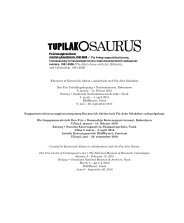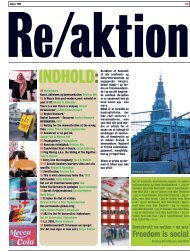tupilakosaurus - Print matters!
tupilakosaurus - Print matters!
tupilakosaurus - Print matters!
Create successful ePaper yourself
Turn your PDF publications into a flip-book with our unique Google optimized e-Paper software.
artaateqarneq. 1996<br />
Kisianni assit tulleriiaat qimerloornerini<br />
imminnut illuatungeriittut<br />
uteqattaartut periaasinngoriartuinnartutut<br />
ipput isumaat<br />
tunorlinngorlunilusooq. Nalunaarasuartaatip<br />
napparussua umiarsuullu<br />
napparutaa; umiarsuup pituutai<br />
nalunaarasuartaatillu aqqutaat;<br />
illumi ningiu nerriviliortoq, piniartorlu<br />
qaannaminik passussisoq;<br />
umiarsuup siua angutillu issianera.<br />
Illuatungeriinnerit isikkumikkut<br />
taamaapput, imminnut assingullutik,<br />
imaakkunanngitsumilli taakku<br />
ataqatigiissutaat immini isumaqartoq.<br />
Pissusissamisut naleqquttumik<br />
tarraninneq allanngortinneqarpoq<br />
illuatungeriinnerillu imartussusiat<br />
tarparlugu.<br />
Assilissat oqaluttuaraat allanik<br />
oqaluttuarneq, soorlu etnografit<br />
(inuit kulturiinik pissusiinillu<br />
ilisimatusartut) – grækerit oqaasiannit<br />
“ethnos” (inuit) – kalaallit<br />
pillugit oqaluttuartarnerat. Aappaa<br />
tassaaginnarpoq angut inuusuttoq,<br />
qaamasumik amilik, pisarneq malillugu<br />
sinniisuusoq inissisimaffimmut,<br />
taakkuninnga isiginniffiusumut, nassaarineqartunut,ajugaaffigineqartunut<br />
allaaserineqartunullu. Kia<br />
kina isigineraa ataasiinnanngorlugu<br />
paasineqarsinnaajunnaarpoq.<br />
Arkep assiliineq nunasiaateqartup<br />
nassuiaanerinut pingaarutilinnut<br />
ilaasutut oqaatigaa, pissutigalugu<br />
tamanna atorneqartarsimammat<br />
nunanik ungasissorsuarniittunik<br />
ajugaaffiginninnernut uppernarsaatissatut.Nalunaarasuartaateqarneq-mi<br />
(nalunaarasuartaateqarneq)<br />
taama imminut oqaasissaqartitaaneq<br />
assit namminneq qularnarsisippaat.<br />
Mette Jørgensen<br />
Pia Arke. Telegraphy. 1996<br />
In the middle of it all stands<br />
Samuel Morse (1791-1872),<br />
American portrait painter and<br />
inventor of the Morse Code<br />
and of electric telegraphy –<br />
from the Greek “tele” (distant)<br />
and “grafein” (to write); that<br />
is, long-distance writing or<br />
communication. The word<br />
reminds one of photography<br />
– from Greek “fos” (light) –<br />
which has often been used as<br />
documentation of the factuality<br />
of historical events.<br />
The black-and-white photograph<br />
of the statue of Morse,<br />
which stands in Central Park<br />
in New York, is the only one<br />
taken by Pia Arke herself on<br />
her visit to the city. The rest<br />
of the photographs, coloured<br />
blue by the artist, relate to<br />
the journey the man in the<br />
pictures made at the end of<br />
the 1940s from Denmark to<br />
Greenland to work as a telegraphist.<br />
The man is placed next to<br />
Morse; one of them on a<br />
plinth, the other on a rock<br />
photographed a little from<br />
below. Both are posing, gazing<br />
into the distance. The two<br />
photographs form the centre<br />
of the series, which extends<br />
symmetrically with eight photographs<br />
on each side of them<br />
as a kind of mirror image of<br />
one another.<br />
On the face of it there seems<br />
to be a logical opposition<br />
between the photographs on<br />
each side. Especially in the<br />
first row where the man on<br />
one side has his arms around<br />
two Danish women and on the<br />
other side around two Greenlandic<br />
women. The water’s<br />
still, sharp reflection of the<br />
landscape. The picture of the<br />
house seen from outside, and<br />
the picture seen from inside<br />
the house looking out.<br />
But the further one moves out<br />
from the centre, the more the<br />
repeated oppositions become<br />
a question of form rather than<br />
of meaning. Telegraph mast<br />
and ship’s mast, ship’s ropes<br />
and telegraph cables; the<br />
housewife bending over the<br />
table and the hunter bending<br />
over his kayak; bow of a<br />
ship and a man’s body seated.<br />
The oppositions are formal,<br />
things that resemble one<br />
another, but it is not given<br />
what the connection between<br />
them signify. The given logical<br />
mirror reflection is distorted<br />
and expands the space of the<br />
oppositions.<br />
The series tells a story about<br />
the other, in the same way as<br />
ethnographers – from Greek<br />
“ethnos” (people) – have told<br />
about Greenlanders. Here,<br />
however, the other is a young<br />
white man, someone who<br />
traditionally represents the<br />
position from which the world<br />
has been seen, discovered,<br />
conquered and described. It is<br />
no longer clear who is looking<br />
at who.<br />
Arke has defined photography<br />
as an important part of the<br />
colonial language, because it<br />
has been used as documentation<br />
of the conquest of distant<br />
regions. In Telegraphy doubts<br />
are raised as to such an<br />
authority by the photographs<br />
themselves.<br />
Mette Jørgensen<br />
45




